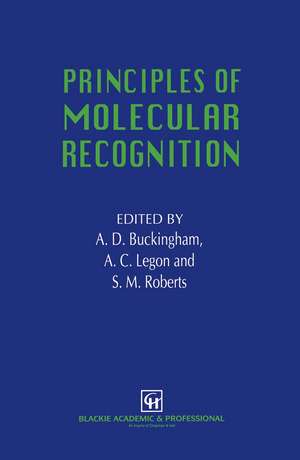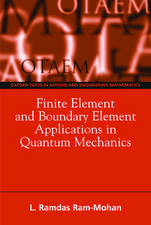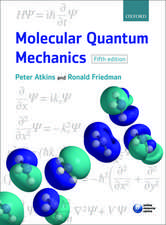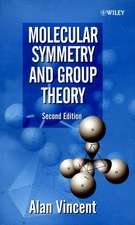Principles of Molecular Recognition
Editat de A.D. Buckingham, A.C. Legon, S.M. Robertsen Limba Engleză Hardback – 30 sep 1993
| Toate formatele și edițiile | Preț | Express |
|---|---|---|
| Paperback (1) | 636.63 lei 6-8 săpt. | |
| SPRINGER NETHERLANDS – 24 sep 2012 | 636.63 lei 6-8 săpt. | |
| Hardback (1) | 642.83 lei 6-8 săpt. | |
| SPRINGER NETHERLANDS – 30 sep 1993 | 642.83 lei 6-8 săpt. |
Preț: 642.83 lei
Preț vechi: 756.27 lei
-15% Nou
Puncte Express: 964
Preț estimativ în valută:
122.100€ • 128.44$ • 101.57£
122.100€ • 128.44$ • 101.57£
Carte tipărită la comandă
Livrare economică 15-29 aprilie
Preluare comenzi: 021 569.72.76
Specificații
ISBN-13: 9780751401257
ISBN-10: 0751401250
Pagini: 200
Ilustrații: XI, 200 p.
Dimensiuni: 155 x 235 x 14 mm
Greutate: 0.49 kg
Ediția:1993
Editura: SPRINGER NETHERLANDS
Colecția Springer
Locul publicării:Dordrecht, Netherlands
ISBN-10: 0751401250
Pagini: 200
Ilustrații: XI, 200 p.
Dimensiuni: 155 x 235 x 14 mm
Greutate: 0.49 kg
Ediția:1993
Editura: SPRINGER NETHERLANDS
Colecția Springer
Locul publicării:Dordrecht, Netherlands
Public țintă
ResearchCuprins
1 Intermolecular forces.- 1.1 Introduction.- 1.2 The Born—Oppenheimer approximation.- 1.3 Molecules and forces.- 1.4 The hydrophobic effect.- 1.5 Classification of intermolecular forces.- 1.6 Vibrational contributions to intermolecular forces.- 1.7 Magnitudes of contributions to the interaction energy.- 1.8 Forces between macroscopic bodies.- 1.9 The effect of a medium.- 1.10 The hydrogen bond.- References.- 2 Molecular recognition involving small gas-phase molecules.- 2.1 Introduction.- 2.2 How to determine the angular geometry and strength of intermolecular binding for an isolated dimer.- 2.3 Empirical observations about angular geometries in the series B ... HX.- 2.4 An electrostatic model for the hydrogen bond interaction: the Buckingham — Fowler model.- 2.5 The electrostatic model and non-bonding electron pairs.- 2.6 A point-charge representation of non-bonding electron pairs.- 2.7 Isomerism in weakly bound dimers: incipient molecular recognition.- 2.8 Dimers with two interaction sites.- 2.9 Consequences of the rules for angular geometries in the solid state.- References.- 3 Spectroscopic studies of solvents and solvation.- 3.1 Introduction.- 3.1.1 History.- 3.2 Background.- 3.3 Ultraviolet spectroscopy.- 3.4 ESR spectroscopy.- 3.5 Nuclear magnetic resonance studies.- 3.6 Vibrational chromophoric probes.- 3.7 Near infrared studies.- 3.8 Use of results from vibrational spectroscopy to interpret magnetic resonance data.- 3.9 Solvation in biological systems.- References.- 4 Origins of enantioselectivity in catalytic asymmetric synthesis.- 4.1 Introduction.- 4.2 Homogeneous hydrogenation with rhodium complexes.- 4.3 Hydrogenation with ruthenium complexes.- 4.4 Carbon—carbon bond formation through cross-coupling.- 4.5 Carbon—carbon bond formation through allylicalkylation.- References.- 5 Molecular recognition in the catalytic action of metallo-enzymes.- 5.1 Introduction.- 5.2 Methods for simulating reactions in enzymes and solution.- 5.3 Application to the staphylococcal nuclease reaction.- 5.4 Concluding remarks.- Acknowledgements.- References.- 6 Drug discovery.- 6.1 Introduction.- 6.2 Receptors as targets for drug design.- 6.3 Enzymes as targets for drug design.- 6.4 Drug discovery by screening: concluding remarks.- Acknowledgements.- References.- 7 Time scales and fluctuations of protein dynamics: metmyoglobin in aqueous solution.- 7.1 Introduction.- 7.2 Methods.- 7.3 Spatial and temporal fluctuations.- 7.4 Conclusions.- Acknowledgements.- References.
Recenzii
This text provides excellent background reading for chemists who have an interest in molecular recognition...it is interesting to read and includes over 350 up-to-date references - Chemistry in Britain; ...excellent background reading for chemists who have a interest in molecular recognition, or for those who are keen to move into one of these areas. - Chemistry in Britain.











